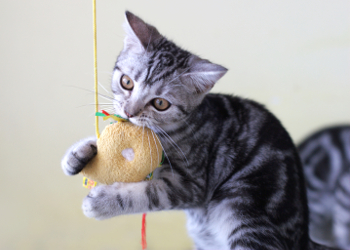Diseases #18

Hypothermia is a severe drop in an animal's corporal body temperature. If temporary, the shivering reflex starts to warm the animal up. In severe cases, it can cause death. Common causes of hypothermia are prolonged exposure to extremely cold outdoor temperatures or cold water for a prolonged period of time. Lowering of corporal body temperatures leads to depression of the central nervous system and vital organs.
Newborn animals may suffer hypothermia right after birth and need to be warmed and stimulated. The young and the old are most susceptible to hypothermia and those animals with a pre-existing medical condition such as congestive heart failure. Dogs and cats without hair will also be more susceptible. The Chinese Crested dog and the Sphinx cat are examples.
Years ago, I treated a Miniature Schnauzer that got stuck in a snow bank and could not get out. It was in that predicament for numerous hours until the owner found the dog. It survived with medical care.
Normal canine and feline body temperatures are about 102.0 F. Hypothermia exists in three stages, with each stage leading to worsening conditions due to an increasingly lower body temperature. Below 96 or so degrees, the shivering reflex stops and if the tide is not corrected, the animal will slip into an eventual coma and perish due to organ failure. With each passing second, lower body temperatures slow down the heart and respiratory rate plus brain activity. The kidneys do not receive adequate blood supply and so on. It is a vicious cycle that results in a complete, total body shutdown.
Clinical signs seen vary with the extent of exposure to cold weather as well as the temperature of the animal when presented. Initially, animals will have a somewhat lower body temperature around 100.0 F. Dogs or cats will often shiver uncontrollably. This is a survival mechanism causing muscular contractions that generate heat. As the condition worsens, animals will have shallow respiration and slow chest movements. They will be weak and or stagger around. In severe cases, animals are completely recumbent or in a coma like condition.
Lab work is usually reserved for animals that have suffered severe hypothermia. A CBC and a Chemistry profile may show concurrent organ failure.
Diagnosis of hypothermia is usually made by a history of exposure to cold air or water temperatures plus physical findings of a sub-normal body temperature and associated clinical signs.
Treatment is geared to slowly raising the body temperatue and associated clinical signs due to hypothermia. Mildly affected animals may just require a physical exam and sent home to sit by a wood burner and wrapped in blankets! Other animals will need to be hospitalized to jump start the body temperature and circulatory system. This is done by infusing warm fluids via an intravenous catheter, covering the animal in blankets and getting the animal to the point where the shivering reflex kicks in. The animal is closely monitored until vital signs and the core body temperature return to normal. Further blood work may also be needed to make sure renal function has been normalized.
The prognosis for those animals receiving immediate care for hypothermia is excellent. Animals presented comatose or in renal failure have a much more guarded prognosis.
Prevention is the key. Minimize exposure to cold temperatures. Keep pets dressed in canine coats and watch them when outside in cold weather. Labradors will try to swim in any water that is not frozen. If you have a pond, monitor it. Newborn animals have to be kept warm. For the first 2 weeks, dogs and cats can not control their body temperature. They are like reptiles during that period. Keep them in a brood box at about 100.0 F. Surgical patients can suffer from hypothermia but all veterinarians take care of that by placing warm circulating water jackets, blankets and or warm water bottles around the animal during surgery.

Hypothyroid is a common disease in older, larger breeds of dogs. Deficiency of thyroid hormones alter the metabolic rate of the animal and can cause general malaise and other issues. The cause is cellular destruction of thyroid tissue. This may be associated with an auto-immune response in the thyroid gland.
The thyroid glands are 2 lobed glands located on each side of the neck by the larynx (voice box). The gland is under control of the pituitary gland. The pituitary gland produces Thyroid Stimulating Hormone (TSH) that causes production of thyroid hormone in the thyroid gland. The two thyroid hormones are T3 and T4. T4 is converted to T3 and the latter is the active hormone. There may be conversion issues in dogs but that is not too common. The numbers after the "T" denote the number of iodine molecules attached. Deficiency in production causes signs of hypothyroidism.
General clinical signs of hypothyroid activity are: lethargy and malaise, weight gain, seborrhea sicca or other dry flaky skin issue, intolerance to cold weather and off and on skin infections.
There are numerous ways to diagnose hypothyroidism in the dog. Cats rarely have deficient thyroid activity.
1. Measurement of both T4 and FT4: The latter is thyroid hormone that is not protein bound. It is used in conjunction with T4 levels to diagnose the condition.
2. TSH Test: In this test a small amount of thyroid stimulating hormone is administered IV. Six hours later blood will be drawn to detect the amount of T4 in the blood. In primary hypothyroid dogs, T4 is not elevated. In normal dogs, it is.
A CBC and Chemistry profile will be drawn to verify organ functioning, making sure the thyroid condition is not secondary to another condition. Cushing's Syndrome dogs will have a depressed thyroid function due to the effect of corticosteroids in the body (cortisol). In those cases the thyroid issue is not treated as it will return to normal once the Cushing's is treated with Trilostane® or Lysodren®.
Diagnosis of hypothyroidism is made by historical and physical findings. Combined with laboratory work such as a TSH test or measuring T4 and FT4, either or both will give a diagnosis of thyroid deficiency.
Treatment of hypothyroidism is geared towards hormone replacement therapy and correcting any pyoderma or seborrhea conditions present. Supplementation with levothyroxine administered twice daily is the treatment of choice in the dog. In several weeks the dog feels better and is much more alert. A month or two later, the lab tests are repeated and adjustments are made to the thyroid dose, if necessary. Once stable, thyroid levels are usually checked twice a year. Skin conditions usually require numerous weeks of antibiotic therapy and shampoos containing chlorhexidine or ketoconazole. Dogs will need to be on hormone replacement therapy for life.
The prognosis for treated hypothyroid animals is excellent. They can continue to live a robust, active life as long as they receive daily doses of levothyroxine. Always make sure you have plenty of medication left before traveling with the animal or over a long holiday weekend.

Hyperparathyroidism is a disease most commonly seen in older dogs and not so common in cats. It is characterized by the production of excess parathyroid hormone. It is grouped into 3 different types:
1. Primary Hyperparathyroidism: This is caused by a tumor (adenoma) of the gland.
2. Secondary (nutritional) Hyperparathyroidism: This is caused by a diet that is insufficient in calcium. This is commonly seen in dogs that are fed a strict meat only diet.
3. Secondary (renal) Hyperparathyoidism: This is seen in renal disease where phosphate levels rise and renal production of calcitreol drops. As a result, excess parathyroid hormone is produced.
1. Primary Hyperthyroidism: In this case a tumor causes production of excess parathyroid hormone. This causes an elevation in serum calcium levels and associated clinical signs.
2. Secondary (Nutritional) Hyperparathyroidism: After being on a strict meat only diet or lack of calcium in the diet. Meat will have excess phosphorus but insufficient calcium. This throws the Calcium/Phosphorus ratio out of whack. Extra parathyroid hormone is produced and calcium is taken out of bone tissues resulting in a weakening of the bone structure.
3. Secondary (renal) hyperparathyroidism: With an increase in phosphorus (due to renal failure) and stimulation of parathyroid hormone, renal function and bone depletion of calcium is made even worse. With calcium depletion and the presence of excess phosphorus, animals will develop "rubber jaw", a severe weakening of the mandible that can lead to fractures due to calcium depletion and excess phosphorus.
The majority of dogs with primary hyperparathyroidism do not show any clinical signs. An elevated serum calcium will be noted. In mild cases, the dog will drink more and urinate more. Anorexia and lethargy will occur but than again, those are general signs of the majority of diseases. In secondary (nutritional) hyperparathyroidism clinical signs produced are poor development of the spinal vertebrae plus an awkward gait due to calcium bone depletion and poor bone development. Young animals are also more prone to fractures due to the poor calcium bone matrix present. In secondary (renal) hyperparathyroidism, signs of chronic renal failure are present such as excessive thirst and urination and the production of a dilute urine.
A CBC and Chemistry profile are performed. In primary hyperparathyroidism, serum calcium levels will be elevated. Ultrasound imaging will be performed to look for parathyroid tumors. Profiles will also show elevated serum phosphorus and signs of renal failure in suspect Secondary (renal) hyperparathyroidism dogs. In Secondary (nutritional) hyperparathyroidism the calcium levels will be low with adequate phosphorus due to inadequate calcium in the diet.
Diagnosis of the primary cause is made by physical exam, lab work and the finding on ultrasound of a tumor on the parathyroid gland. The secondary (nutritional) cause is made by the presence of a young animal with a deformed skeleton and the presence of fractures in young animals. The history of feeding an exclusive meat diet is of utmost importance in the diagnosis. The secondary (renal) cause is made by looking at lab work indicative of chronic renal failure or rubber jaw. Bone depletion also occurs in these cases. Hyperparathyroidism is so common in chronic renal failure dogs that it should always be thought of when dealing with the renal failure.
1. Primary Hyperparathyroidism: Treatment is geared towards surgical removal of the adenoma. Care must be taken post op in monitoring calcium levels. Some animals serum calcium will drop precipitously and must be give intravenous calcium gluconate and discharged on oral calcium supplementation. Oral products take about 3 days to raise serum calcium so animals will have to hospitalized until the level rises.
2. Secondary (nutritional) Hyperparathyroidism: Treatment is by putting the dog on an appropriate diet with nutritional supplements such as Nutrical®. The animal must be removed from an all meat diet. Any skeletal deformities are irreversible.
3. Secondary (renal) Hyperparathyroidism: The goal is reversing or controlling chronic renal failure. This is difficult. Offering phosphate binders such as Aluminum Hydroxide will help to lower serum phosphates. Diets lower in phosphorus will also help. Hill's® Prescription Canine k/d is a good choice.
The prognosis for primary hyperparathyroidism is good and depends upon the surgical removal of the adenoma and proper regulation of serum calcium. The prognosis for the secondary (nutritional) hyperparathyroidism is very good once the animal is placed on a nutritionally balanced diet. The prognosis for secondary (renal) hyperparathyroidism is guarded since the main problem is correcting chronic renal failure which is difficult.

Hyperthermia is a life threatening condition in dogs and cats. It is defined as an excessive elevation in the corporal body temperature due to excessive environmental heat. This is seen much more commonly in dogs and almost never in cats. Cats sleep most of the day when it is hotter and are more active at night when temperatures have cooled off. Hyperthermia is different from fever. Fever is a elevation in body temperature secondary to a viral or bacterial presence in the animal. Fever of Unknown Origin (FUO) is a fever not caused by bacteria or viruses but more commonly by auto-immune diseases or certain cancers.
A dog or cat normal body temperature is around 102.0 F. Hyperthermia leads to signs of heat exhaustion and heat stroke. It is not just the environmental heat that causes problems but the humidity present at the same time. I have had dogs suffer heat stroke even though the temperature was in the mid 80's but the relative humidity was even higher. Heat related illnesses always occur during warm weather. In Florida, that means year round. Leaving animals outdoors without shade or water, in cars with windows rolled up and even taking a dog for a walk in mid day sun can send an animal over the edge.
Dogs can not perspire like humans or horses. The only exception to that rule is the Chinese Crested dog. It has sweat glands on its skin. Sweat helps to wick heat away and attempt to cool the body temperature. Dogs and cats only have sweat glands at the base of each foot pad. Totally inadequate. A dog or cats response to eliminating heat is by panting. Excessive saliva is produced which will wick away respiratory heat but this system easily gets overloaded compared to humans. This explains all the clinical signs seen.
Clinical signs of hyperthermia vary with the severity of the condition. In early stages, the dog will pant and its heart rate and respiratory rate will increase. As the condition worsens, the animal becomes weak, lethargic and disoriented. If not corrected vomiting and a blood tinged diarrhea may occur. Extreme heat stroke can be fatal. Dogs will seizure due to brain swelling. That seizure activity makes the heat stroke worse since seizures cause muscle contractions which produce more heat. That is the last thing a dog needs! The dog will go into renal failure plus clotting difficulties such as DIC (Disseminated Intravascular Coagulopathy) will usually occur. The blood figuratively boils. Animals in this latter state rarely survive. Early heat stroke will produce a rectal temperature of between 104.0 F-105.0 F. Severe heatstroke signs develop when the corporal body temperature is over 107.0 F.
A CBC and Chemistry profile are always performed. In advanced cases the BUN and Creatinine will be elevated indicating renal failure. Checking a blood sample for clotting time is crucial. The hematocrit will usually show a dehydration effect, that is it will be quite elevated above normal.
A diagnosis of hyperthermia and heat stroke are made based on the history of an animal trapped in excessive heat and or humidity conditions as well as an extremely high rectal temperature. The time of the year (in temperate climates) will lead to suggest it as the primary cause.
Treatment goals are the immediate decrease of the corporal body temperature. At home, if owners suspect a heat stroke case, is to hose off the animal with water and wrap a water soaked blanket around the animal and seek immediate medical attention. In the hospital blood will be drawn and intravenous fluids to correct shock, dehydration and renal function. Usually dogs are flushed with cold water until the body temperature reaches about 103.5 F. At that time the temperature will slowly glide down to about 100.0 F- 101.0 F where the shivering reflex will raise it back to normal. Water is initially sprayed towards the base of the lower brain stem. This is the closest point between the exterior of the body and the hypothalamus. This is the body's main thermostat so applying water directly in the vicinity will help lower body temperatures. In mild cases animals usually respond quickly. In severe cases, seizures are controlled by diazepam. Dogs that suffer from acute renal failure are hospitalized until serum chemistries are normal, urine output has improved plus the animal is alert and eating and drinking on its own. DIC can be handled with heparin but it is risky business treating it.
The prognosis for the majority of hyperthermia cases is excellent once medical care is sought and promptly treated. Prognosis for animals suffering from secondary seizures, renal failure and DIC is more guarded. The successful treatment of those secondary issues dictate the overall survival of the animal.
Prevention is the key. Never leave animals in cars alone with the windows rolled up. Do not leave the pet without water or shade if left outside. The cooling mechanism naturally found in dogs and cats is far inferior to that of humans. An animal will do better in extreme cold situations than extreme hot, humid situations. In hot weather, keep the animal in an air conditioned environment. If you usually walk the dog, do so in the early morning or evening. DO NOT ride a bicycle and have a dog tethered to it making it run in hot weather. That is a guarantee to develop heat exhaustion.

Hyperthyroidism is the most commonly seen endocrine disease in the older cat. Most cats are about 10 years of age and older when diagnosed with the condition. Hyperthyroid is caused by excessive thyroid hormone by one or both of the thyroid glands.
Thyroid hormone influences practically every function in the body. It is crucial for the animals mental, alert state. Skin condition, maintenance of body weight, heart and respiratory rate are under its control. The thyroid glands are two lobed glands located on each side of the larynx (voice box).
When excess thyroid hormone enters the blood system, all body systems go into "over drive". The clinical signs seen arise from this excess hormone production.
The majority of cats are over 10 and in my Ohio practice all of the cats were black in color! Excessive thirst, urination, weight loss, nervous activity, poor coat condition, increased appetite and irritability are the main signs seen in cats.
In advanced cases, excess thyroid hormone will lead to feline hypertrophic cardiomyopathy. Cats presented with signs of hyperthyroid may also have murmurs present and actual signs of congestive heart failure if the heart is dilated.
When suspecting feline hyperthyroidism, a CBC and Chemistry profile are performed to analyze metabolic bodily functions. The crucial test that determines the condition is the T4 and FT4 thyroid tests. If the T4 is elevated and the FT4 is not, wait on a diagnosis and repeat the test later. If the FT4 is elevated, the T4 will usually also be up and a diagnosis of hyperthyroid can be made. There are cases where you know the cat is hyperthyroid but the lab tests do not confirm it. Wait 3-6 months and repeat the thyroid tests. The majority of the times the values will be elevated. That is just being "a cat". Cats always try to outfox veterinarians.
If secondary hypertrophic cardiomyopathy is suspected, a cardiac ultrasound and an Idexx® Pro-BNP test are recommended.
A diagnosis of hyperthyroidism is made by taking into account the historical findings, the age of the cat and physical exam. The thyroid function tests will confirm the diagnosis.
There are many causes of excess thirst, urination and weight loss in pets. The prime rule out here is Diabetes mellitus. It is characterized by concurrent hyperglycemia and glucosuria. Chronic liver disease will have elevated liver enzymes and altered metabolites present. Chronic renal disease will have elevated BUN, Creatinine and Phosphorus. The urine produced is dilute. These all differ from feline hyperthyroidism.
Treatment is geared towards lowering the thyroid hormones back into a normal range. This can be accomplished three ways:
1. Putting the animal on Tapazole® (methimazole), on an initial loading dose and maintenance dose, will lower the thyroid hormones back to a normal range in a few weeks. The drug prevents the formation of thyroid hormones. The disadvantage to this: cats hate to be pilled. Independent compounding labs are able to manufacture a paste that is applied daily to the ear flaps. Use gloves when applying this to the animal's ears. This replaces oral therapy. It is a daily life long commitment and if therapy stops abruptly the thyroid hormones will resume their climb back to excessive levels. Problem is, is that long term use of the drug does not stop the thyroid adenomas from growing. T4 and FT4 levels have to be checked frequently until the cat is stabilized and than twice a year.
2. Surgical removal of the thyroid glands. This is straight forward but the big problem is that the parathyroid gland is diffuse and can not be differentiated visually from the thyroid gland in the cat. There may be future serum calcium issues.
3. Radioactive Iodine. This is a costly procedure but it is a one time treatment in the cat. Methimazole is not cheap so the cost over the life time of the cat is more reasonable. It requires no anesthesia and the drug is administered subcutaneously. This procedure is only performed in facilities that have a special license. Animals are all hospitalized. Great thing is, is that thyroid hormone levels reach normal limits in a week or two.
Cats that have developed secondary cardiomyopathy will need to be treated for that disease.
The prognosis for most cats treated for feline hyperthyroidism is very good. Seeing an animal go from a wasted, gaunt condition to a thriving older cat is rewarding. Long term prognosis is based on the development of the thyroid adenoma as well as the long term treatment that had been decided on. Long term survival is better with radioactive iodine than methimazole for the simple reason that in the latter, the tumor growth is not inhibited.

